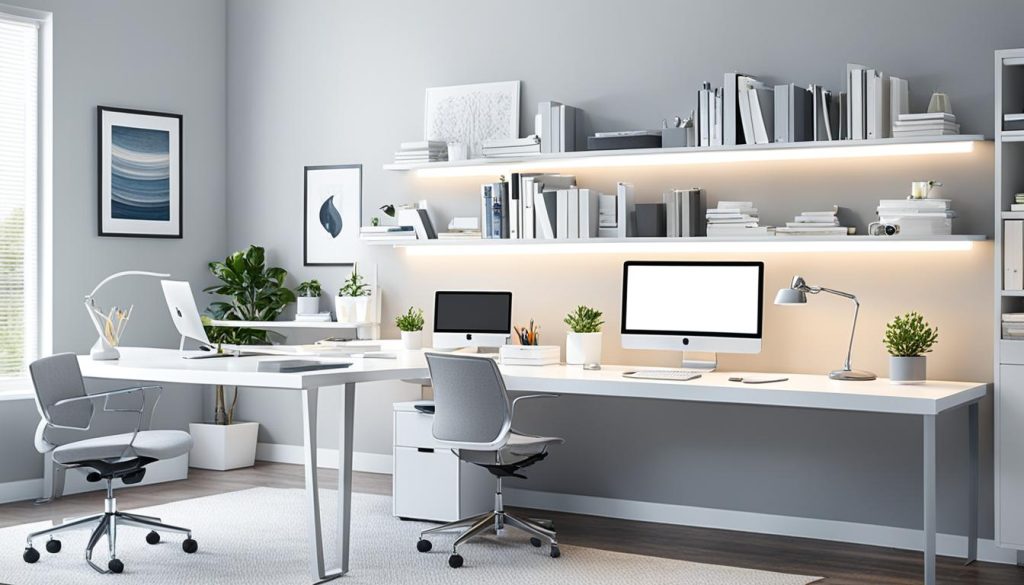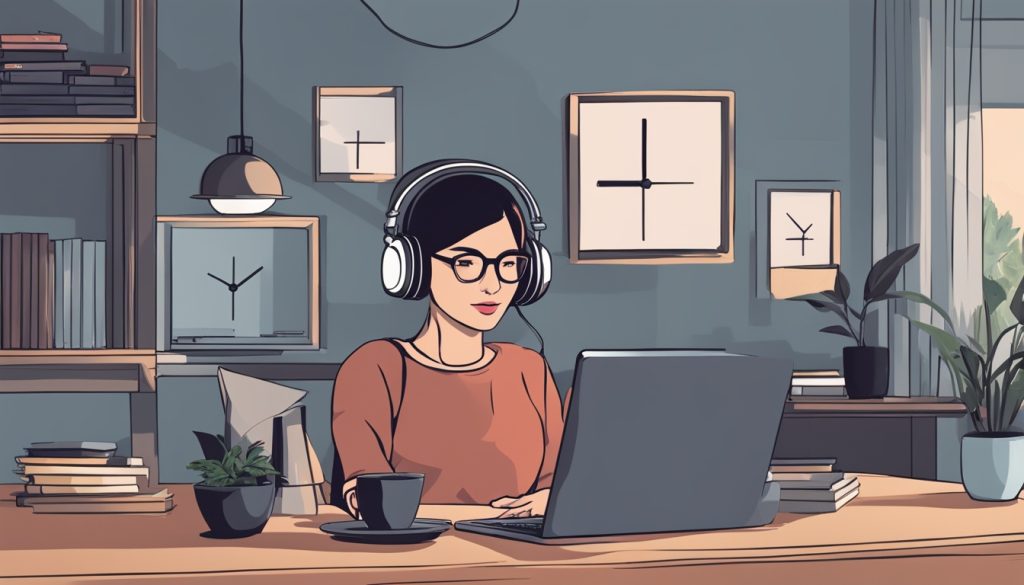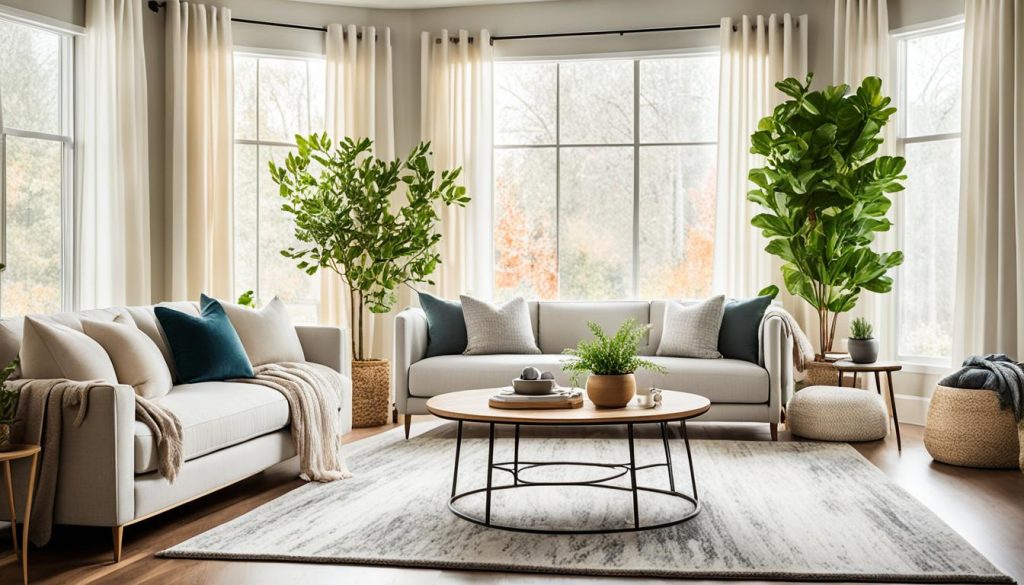With the COVID-19 pandemic, many people are now working from home. This has brought a new challenge: dealing with noise at home. Studies show that 73.4% of 1,552 people have worked from home before. Many struggle with noise that affects their work and focus1. So, how can you make your home office quieter and more focused?
Over 64.8% of people get distracted by noise from outside their homes. And 61.8% of distractions come from within their homes1. Things like family, pets, and construction noise make it hard to focus. To solve this, we need to look at soundproofing and noise-reducing accessories. These can help turn your home office into a place where you can focus well.
Understanding Noise Pollution in Remote Work
Noise pollution is a big problem for remote workers. Home environments often have many sounds that can distract and reduce focus2. Things like household appliances, street noise, neighbors, family, and pets can make it hard to work well.
Common Sources of Noise in the Home
Household appliances like washing machines and dishwashers are big noise makers for remote workers2. Street noise, including traffic and construction, can also get into the home2. Family, roommates, and pets can also be a challenge because their sounds are hard to control.
Impact of Noise on Productivity and Focus
Noise pollution can really hurt how well remote workers do their jobs3. Research says a noisy place can cut worker productivity by up to 86 minutes3. Open-plan offices make workers up to 66% less productive than working alone4. Noise can also make people’s heart rate and blood pressure go up, making them work worse4.
To fight noise pollution, remote workers need to make a quiet space at home2. Having a quiet area away from busy spots helps reduce distractions and boosts focus2. Using soundproof curtains, acoustic panels, and sealing gaps can also help block out external noise and make working better2.
Creating a Dedicated Workspace
Setting up a dedicated workspace at home can greatly improve your focus and productivity5. It helps block out household noise, letting you concentrate better on your tasks5.
Think about making a quiet spot, like an extra bedroom or a quiet corner, your work area5. A spare room gives you privacy and keeps out household noise5. Or, you could use a spot in the dining room or kitchen for good light and space, but you’ll need to work on keeping it quiet5.
Keeping your desk tidy can make you feel fresh and ready for work5. Using an ergonomic chair or a standing desk can also reduce the discomfort from sitting a lot5. Adding things like plants or photos can make your workspace welcoming and boost your productivity5.
Having a separate workspace helps you separate work from personal life5. A clear workspace signals to your brain that it’s time to stop working, improving your work-life balance5. This can lead to more productivity and better relationships with everyone at work and home5.
| Benefit | Description |
|---|---|
| Improved Productivity | A dedicated workspace means more focus, fewer distractions, and better time management, which boosts productivity6. |
| Enhanced Comfort and Ergonomics | Customizing your workspace with ergonomic furniture and personal items can make it more comfortable and efficient, reducing health problems6. |
| Noise Reduction and Privacy | Using sound-absorbing materials and double-glazed windows can make your workspace quiet and private, helping you concentrate and work better6. |
| Improved Work-Life Balance | Separating work and personal areas helps create clear boundaries, making it easier to “switch off” after work5. |
In summary, setting up a dedicated workspace at home is a smart move for your productivity and health. By focusing on noise, lighting, ergonomics, and organization, you can create a supportive work environment for remote work success567.

Soundproofing Techniques for the Home Office
Soundproofing your workspace can help block out external noises and create a more conducive environment for focused work. Using soundproof curtains can absorb sound and light, reducing distractions from outside8. Also, acoustic panels on the walls can help minimize echo and noise, making the sound quality better8.
Sealing gaps and cracks around windows and doors is key to soundproofing your home office9. Filling holes in the walls with caulk and choosing a solid wood door over a hollow one can greatly reduce noise9. Adding a door sweep, like the Suptikes Soundproof Under Door Seal, can also help with noise reduction9.
Using Soundproof Curtains and Acoustic Panels
Soundproof curtains are great for absorbing sound and light, making your work area more focused and distraction-free.
Acoustic panels help reduce echoes and noise, improving the room’s acoustics8. Place these panels on walls to target noise issues and boost your home office’s soundproofing.
Sealing Gaps and Cracks
Sealing gaps or cracks around windows, doors, and walls is vital to keep sound out of your workspace9. Using caulk or weatherstripping can block these openings. Switching to a solid wood door can also help reduce noise9. Adding a door sweep ensures an airtight seal, keeping unwanted sounds out of your office9.
With these soundproofing tips, you can make your work area more productive and focused. A well-designed and soundproofed home office can boost your productivity and well-being8.
Noise Reduction in Work From Home Environments
To reduce noise at home while working, you need to make changes to your workspace and talk with your family. Making your workspace quieter, using headphones, and setting rules with your family can help you focus better10.
The Institute of Noise Control Engineering of the USA suggests getting good noise-canceling headphones or earbuds. These tools can block out sounds you don’t want, letting you concentrate on your work10.
Using noise-canceling tech is just one way to make your workspace quieter. Adding sound-absorbing materials like rugs, curtains, and panels can also help. These items can make your home office quieter and more peaceful10.
Talking to your family and setting noise rules is another good idea. You might make some areas or times quiet, where no loud activities are allowed10.
By trying these methods together, you can make working from home better for focus and productivity. This can improve your work performance and your well-being10.
| Noise Reduction Strategy | Description |
|---|---|
| Noise-Canceling Headphones | Invest in high-quality noise-canceling headphones or earbuds to effectively block out unwanted sounds. |
| Sound-Absorbing Materials | Incorporate elements like rugs, curtains, and acoustic panels to reduce the overall noise level in your home office. |
| Household Communication | Establish clear guidelines with your household members, designating quiet zones and times to minimize disruptions. |
Using these Noise Reduction Strategies and Remote Work Noise Management tips can make your home office quieter and more productive. This helps you do your best work10.

Investing in Noise-Canceling Headphones and Earbuds
Working from home11 can be better with noise-canceling headphones. These devices block out background sounds, helping you focus11. They are a smart buy to avoid stress and fatigue from loud noises.
11 These headphones boost productivity by cutting down on distractions at home11. Prolonged loud noises can harm your hearing. When picking the right audio gear11, look for adjustable headbands, a light design, quality materials, connectivity options, and easy controls. These features make a big difference in a remote work setup.
12 In 2019, noise-canceling headphones were a top gift choice12. The CDC says 22 million workers face harmful noise yearly12. ANC headphones are great for loud places like busy restaurants or airports. PNC devices are good for constant or sudden noises, like loud machines or gunshots12.
| Headphone Model | Price | Notable Features |
|---|---|---|
| Bose QuietComfort 45 Headphones | $329.00 | Up to 24 hours of battery life, various color choices |
| Master & Dynamic MW75 Headphones | $499.00 | 3 ANC modes, up to 32 hours of battery life, multipoint connection |
| Soundcore Space Q45 Headphones | $199.99 | Custom noise cancelling with 5 levels, up to 65 hours of battery life |
| Edifier WH950NB Headphones | $149.99 | Active noise cancellation, ambient sound aware modes, up to 55 hours of battery life |
| Bowers & Wilkins Px8 Headphones | $699.00 | Adjustable noise cancellation modes, 30 hours of battery life, various color choices |
| Beats Studio Pro Headphones | $349.95 | ANC mode, transparency mode, engineered leather cushions for comfort |
13 PCMag tested 77 headphones last year13. They found top picks for noise-canceling headphones and earphones, priced from $199.00 to $429.0013. Discounts on headphones ranged from $9.01 to $150.00 are also highlighted.
13 Popular models include the Apple AirPods Pro (2nd Generation) at $199.00, the Bose QuietComfort Ultra Earbuds at $299.00, and the Bose QuietComfort Ultra Headphones at $429.0013. Reviews cover noise cancellation, audio quality, and connectivity.
Choosing the right noise-canceling gear means looking at11 over-ear headphones for better noise blocking. Also, consider11 the comfort and adjustability of models with memory foam or plush cushions. Being able to adjust the noise cancellation is also useful, for when you want to hear sounds around you.
Investing in quality noise-canceling headphones or earbuds can greatly improve your work-from-home experience. With brands like Bose, Sennheiser, and Sony, you can find the right gear for your needs and budget111213.
Using Background Music and White Noise
For remote employees, having a quiet work space is key. Using background music or white noise can help block out distractions and improve focus. Studies show that sound can make speech more private and boost productivity in many places, like offices and hospitals.
Exploring Ambient Sound Playlists
Soft, instrumental background music or white noise can set the stage for better focus14. There are many online and mobile apps with ambient sound playlists for staying focused, like sounds of nature, rain, or soft piano15. Try out different ambient sounds to see what’s best for your home office.

White noise might be too loud and annoying, but sound masking systems aim to create a deeper, smoother sound experience16. By planning your home office well, you can set up a sound environment that cuts down on distractions and boosts your work16.
Finding the right mix of background music, white noise, or ambient sound is important for your work-from-home setup15. Try different sounds to see what keeps you focused and productive all day.
Scheduling Work Around Quiet Times
If you can pick when you work, choose quieter times to boost your productivity. For instance, if mornings are loud due to construction, start your work later when it’s quieter17. Also, talk to family or roommates to keep noise down during your work hours18.
Planning your work for quiet times helps you work in peace. This lets you focus better and get more done without interruptions18. It’s a smart way to work efficiently.
- Find out when it’s quietest at home or in your area and work then.
- Talk to others living with you to agree on “quiet hours” to reduce noise.
- Use flexible work times, like early mornings or late evenings, to dodge loud times.
Working at quieter times makes your work space better for focus and productivity17. This, along with other ways to reduce noise, can make working from home better19.

Utilizing Rugs and Carpets for Sound Absorption
Rugs and carpets are key to a quiet and productive home office. They act as sound absorbers, cutting down noise and improving sound quality20.
A carpet can lower ambient noise by 35% on average20. Choosing a wool carpet can reduce noise by 46%20. Adding an underlay can boost noise reduction to 50% to 70%20.
When picking a carpet or rug, think about thickness and material. Thicker, high-pile rugs absorb sound better. Carpets also help keep your space warm, use less energy, and catch dust and allergens, making the air cleaner20.
| Carpet Pad | Price Range (per sq ft) |
|---|---|
| Carpet | $1.40 – $8.79 |
| Carpet Pad | $0.66 – $6.60 |
For the best acoustic rug pad, consider Duralux 7mm. It’s known for top-notch sound insulation and durability21. Duralux 7mm’s dense rubber absorbs impact noise and offers lasting soundproofing21.
Using quality rugs and carpets in your home office makes it quieter and more productive. It reduces noise and improves sound quality. 
Communicating with Household Members
Working from home means you need to talk openly with your family about your work hours and quiet times22. It’s important to share your work tasks and meeting times with your family or roommates. This helps them keep noise down during important work times22.
Establishing Quiet Hours
Setting quiet hours at home can boost your productivity and focus22. Work with your family to pick the best quiet times. Make sure everyone knows and respects your work needs22. You might decide on certain hours when everyone should be quieter or use other rooms to avoid disturbing you22.
Good communication and understanding are key for a peaceful remote work life22. By setting quiet hours and getting your family involved, you can make your home office better22.
Good communication and quiet hours are key for remote work manners22. These steps help cut down on distractions and make your home office better for work22.
| Household Communication Strategies | Benefits |
|---|---|
| Discuss work schedule and important meetings | Promotes household awareness and consideration |
| Establish designated quiet hours | Enhances productivity and focus |
| Involve household members in the process | Fosters mutual understanding and cooperation |
Using these strategies helps you share your remote work needs and makes your work area better for focus and productivity22. Keeping an open line with your family and setting clear rules makes remote work smoother22.
Along with quiet hours, try noise-reducing tips like noise-canceling apps or soundproofing solutions to improve your home office23. These ideas, along with good communication, can make your remote work space quieter and more productive23.
Noise-Reducing Accessories for the Home Office
Working from home means you need a quiet space to focus. Luckily, there are many accessories that can help reduce noise and boost productivity2425.
Door draft stoppers are great for keeping noise out. They seal the gap under your office door, stopping sounds from coming in from other parts of your home25.
Window inserts are also useful. These panels fit into your office windows, adding an extra layer of insulation to block out outside noises25.
- Putting bookshelves against shared walls can help block noise. They absorb and reduce sounds25.
- Adding area rugs and carpets to your office can improve sound absorption. This makes your space quieter and more peaceful25.
Using these Noise-Reducing Home Office Accessories and Sound Insulation Products can make your workspace quieter and more focused. This lets you work better and stay well while working from home2425.
Finding Roommates Compatible with Remote Work
Living with the right roommates can greatly improve your home’s noise levels. Using platforms like SpareRoom, a roommate-matching website, can help you find roommates who fit your work-from-home needs. They’ll also respect the need for a quiet workspace26.
Using SpareRoom for Roommate Matching
Apps like SpareRoom let you find roommates easily from home, at your own time27. They connect you with people from different backgrounds and places27. The apps use smart algorithms to match you with roommates who share your lifestyle and habits27.
These apps also have safety features like user checks and secure messaging27. You can set your search criteria to match your needs, like location and budget27. They offer messaging, video calls, and meetings to help you connect with potential roommates27. This makes finding the right roommate easier and safer.
Using SpareRoom and similar platforms can boost your chances of finding compatible roommates. This leads to a more productive and peaceful living space26.
| Roommate Finder App | Key Features | Pricing |
|---|---|---|
| SpareRoom | Compatibility matching, secure communication, user verification | Free basic account, paid subscription options for additional features |
| Roomi | Free account creation, Roomi Gold, Solo Agent, and Unlimited plans | Free basic account, paid subscription options |
| Diggz | Find roommates, rooms for rent, and full rentals, secure communication | Free basic account, paid subscription options |
| Roomster | Global platform, social connectivity, pet-friendly options | Free basic account, paid subscription required for certain features |
With SpareRoom, you can find housemates who get the challenges of remote work. This leads to a more productive and peaceful living space26.
Importance of Acoustic Treatment
Proper acoustic treatment is key for a productive home office. By using sound absorption and smart design, you can cut down on distractions. This leads to better focus, more productivity, and a happier you282930.
Acoustic panels can cost from $70 for basic ones to over $700 for top-tier models. They’re a smart way to boost sound quality in your workspace28. But, cheaper panels might not match the quality of pricier ones. So, it’s important to find a balance between cost and quality28.
Acoustic panels help reduce noise pollution in offices, especially big ones where sound can easily spread and disturb others30. They make speech clearer, which improves communication, teamwork, productivity, and reduces stress in loud places28.
Acoustic treatment mainly deals with controlling echoes and reverberation in rooms29. It absorbs sound, cutting down on the energy that bounces around29. Without it, rooms can have big differences in sound levels. But with it, you get clearer sound, better note clarity, and a more enjoyable time listening to music or watching movies29.
Adding acoustic treatment can make communication, focus, work or study productivity, and listening experiences better in any room29. It also helps in making accurate audio mixes by creating a consistent sound environment. This is crucial for places where voice recordings or transmissions happen, reducing echoes and reverberation for clear sound29.
Acoustic treatment often includes panels for absorbing sound, bass traps, and diffusion elements29. The best low-frequency absorption comes from thick panels, which can absorb sound down to certain frequencies29. Knowing what materials are in acoustic panels is important. Rigid fiberglass panels work well across different frequencies29.
Using acoustic solutions can greatly improve your work space with easy setup and little downtime30. Getting advice from experts like Wallworks can help create the perfect acoustic setup that fits your space, sound needs, and budget30. Wallworks has been a top provider of acoustic solutions in Canada for over 40 years, offering the latest in acoustic products30.
Combining Multiple Strategies for Optimal Results
To reduce noise at home while working, you need a full plan. Use Comprehensive Noise Reduction Strategies like having a special workspace, soundproofing, noise-canceling tech, and talking with family. This way, you can make your Optimize Remote Work Environment better. It helps you work more efficiently, stay focused, and feel comfortable31.
Having a specific spot for work helps cut down on distractions and noise. Use acoustic panels and seal gaps for better sound quality. Noise-canceling headphones or earbuds can also help block out distractions, letting you focus on your tasks31.
Talking with your family about quiet times and using rugs and carpets can make your workspace quieter. By using many strategies together, you can make a work area that’s good for your health and work31. These steps can turn your home office into a place where you can focus and be productive31.
Source Links
- https://www.soundproofcow.com/soundproofing-work-from-home/
- https://seaislenews.com/remote-working-combating-noise-pollution-home/
- https://medium.com/it-paragon/managing-noises-and-sound-during-work-from-home-9cd4a32ecc61
- https://www.metrikus.io/blog/noise-pollution-is-killing-your-productivity-what-can-you-do-about-it
- https://www.beck-technology.com/blog/working-from-home-tips-dedicated-workspace
- https://www.matsh.co/en/how-can-i-create-a-dedicated-workspace-at-home-to-increase-productivity/
- https://www.nationalbusinessfurniture.com/blog/workspace-solutions-that-minimize-noise-and-boost-productivity
- https://krisp.ai/blog/cubicle-noise-reduction/
- https://www.bobvila.com/slideshow/10-tips-for-soundproofing-your-home-office-265365/
- https://www.firstcarbonsolutions.com/blog/10-tips-to-control-noise-while-working-at-home/
- https://www.forbes.com/sites/terriwilliams/2023/11/09/if-you-work-from-home-noise-cancelling-headphones-are-essential/
- https://www.soundproofcow.com/noise-canceling-headphones/
- https://www.pcmag.com/picks/the-best-noise-cancelling-headphones
- https://askjan.org/workrelatedfunctions/Noise.cfm
- https://www.soundproofcow.com/noise-at-work/
- https://cambridgesound.com/difference-between-white-noise-sound-masking/
- https://www.corporatesuites.com/how-to-reduce-noise-in-a-shared-office/
- https://www.activtrak.com/blog/workplace-disruptions/
- https://resonics.co.uk/our-blog/13-ways-to-reduce-noise-in-your-office/
- https://www.decosurfaces.com/en/blog/18-carpet-soundproofing-transforming-the-sound-environment-in-your-home.html
- https://duracushion.com/blogs/blog/the-ultimate-guide-to-soundproof-floor-mats-achieve-quiet-floors-with-duralux
- https://www.ccohs.ca/oshanswers/hsprograms/telework.html
- https://www.design-reuse.com/industryexpertblogs/53700/enhancing-audio-quality-with-environmental-noise-cancellation-in-sound-processing.html
- https://hushoffice.com/en-us/the-quick-comprehensive-guide-to-office-noise/
- https://www.soundproofcow.com/soundproofing-101/office-soundproofing/
- https://blog.hubspot.com/marketing/working-remotely-with-roommates-or-family
- https://www.mystackbox.com/roommate-finder-app
- https://www.officefinder.com/officeblog/benefits-using-acoustic-panels-workplace/
- https://www.soundguys.com/soundproofing-vs-acoustic-treatment-50463/
- https://www.wallworks.com/acoustic-materials-for-the-work-place/
- https://blogs.cdc.gov/niosh-science-blog/2020/11/20/working-from-home/

